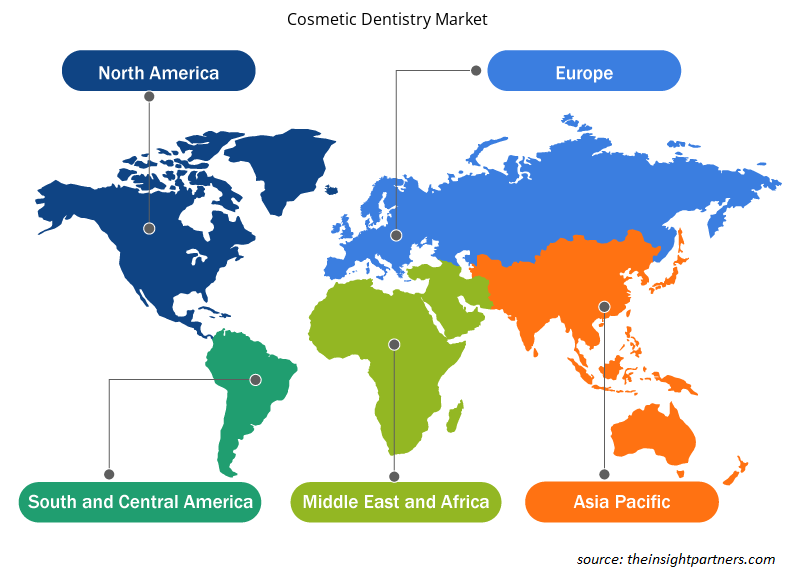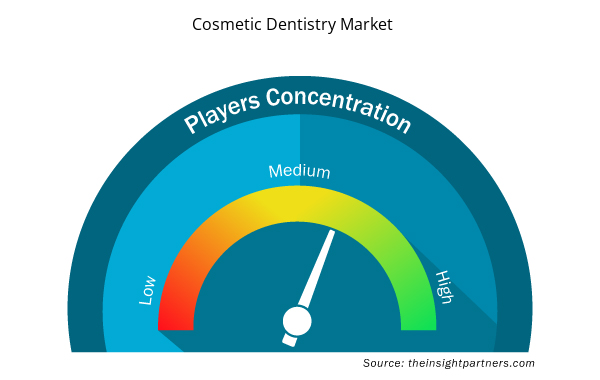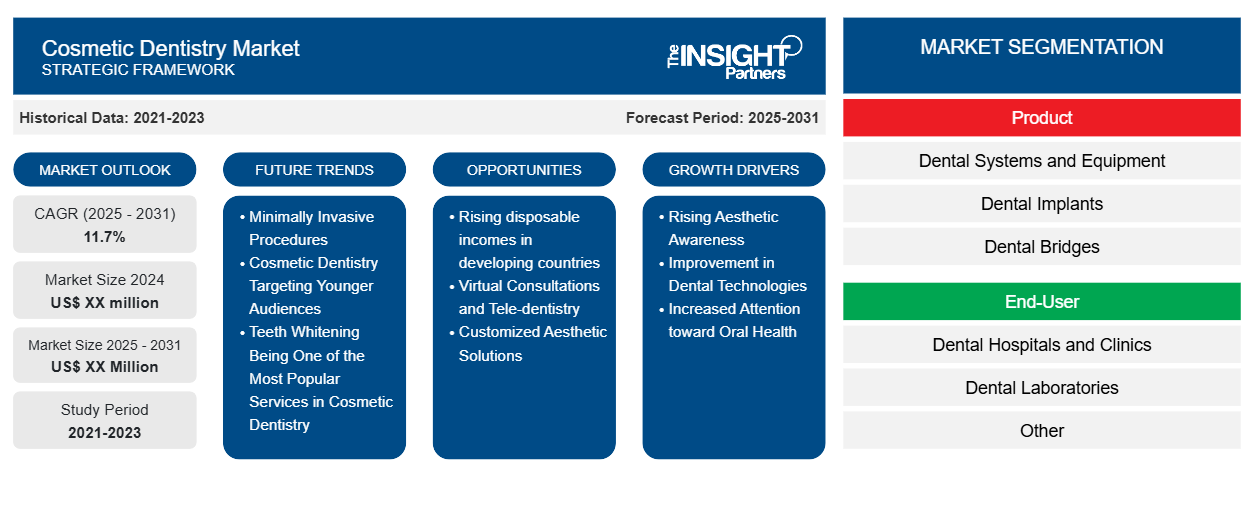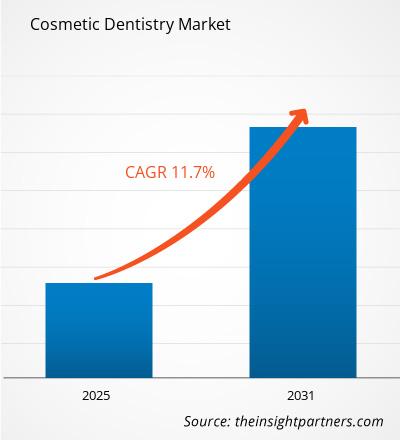Se espera que el mercado de odontología cosmética registre una CAGR del 11,7 % entre 2024 y 2031, con un tamaño de mercado que se expandirá de US$ XX millones en 2024 a US$ XX millones en 2031.
El informe está segmentado por producto (sistemas y equipos dentales, implantes dentales, puentes dentales, coronas dentales, carillas dentales, prótesis dentales, aparatos de ortodoncia, agentes adhesivos, incrustaciones y onlays). El informe está segmentado por usuario final (hospitales y clínicas dentales, laboratorios dentales, otros). El análisis global se desglosa aún más a nivel regional y por países principales. El informe ofrece el valor en USD para el análisis y los segmentos anteriores.
Propósito del Informe
El informe Cosmetic Dentistry Market de The Insight Partners tiene como objetivo describir el panorama actual y el crecimiento futuro, los principales factores impulsores, los desafíos y las oportunidades. Esto proporcionará información a diversas partes interesadas del negocio, como:
- Proveedores/fabricantes de tecnología: Para comprender la dinámica cambiante del mercado y conocer las oportunidades potenciales de crecimiento, lo que les permitirá tomar decisiones estratégicas informadas.
- Inversionistas: Realizar un análisis exhaustivo de tendencias sobre la tasa de crecimiento del mercado, las proyecciones financieras del mercado y las oportunidades que existen en toda la cadena de valor.
- Órganos reguladores: Regular las políticas y vigilar las actividades del mercado con el objetivo de minimizar los abusos, preservar la confianza de los inversores y defender la integridad y la estabilidad del mercado.
Segmentación del mercado de odontología cosmética
Producto
- Sistemas y equipos dentales
- Implantes dentales
- Puentes dentales
- Coronas dentales
- Carillas dentales
- Dentadura postiza
- Aparatos de ortodoncia
- Agentes de unión
- Incrustaciones y onlays
Usuario final
- Hospitales y clínicas dentales
- Laboratorios dentales
- Otro
Personalice este informe según sus necesidades
Obtendrá personalización en cualquier informe, sin cargo, incluidas partes de este informe o análisis a nivel de país, paquete de datos de Excel, así como también grandes ofertas y descuentos para empresas emergentes y universidades.
- Obtenga las principales tendencias clave del mercado de este informe.Esta muestra GRATUITA incluirá análisis de datos, desde tendencias del mercado hasta estimaciones y pronósticos.
Factores impulsores del crecimiento del mercado de la odontología cosmética
- Aumento de la conciencia estética: muchos factores pueden llevar a la proliferación de los mercados de la odontología cosmética, pero probablemente el más destacado sea la creciente preocupación por la autoimagen entre los miembros de la población. Cuanto más nos preocupamos por las definiciones sociales de belleza y cuidado personal, más empezamos a prestar atención a la sonrisa, que puede contar o arruinar la historia de la apariencia general de una persona. El aumento de este efecto social también es resultado de la forma en que los canales de las redes sociales han mejorado el contacto con algunos de los grandes influencers y celebridades que han demostrado ser tan abiertos a la hora de mostrar sus transformaciones dentales en línea. Estas tendencias culturales han desmitificado mucho sobre la necesidad de procedimientos cosméticos como el blanqueamiento dental, las carillas y los cambios de imagen de la sonrisa.
- Mejoras en las tecnologías dentales: Los avances tecnológicos modernos en odontología han mejorado enormemente la precisión, la comodidad y los resultados de los procedimientos cosméticos. Desde la perspectiva de campos como la medicina dental digital, las imágenes en 3D junto con los sistemas CAD/CAM pueden hacer maravillas en la gestión eficaz de la investigación diagnóstica y la planificación del tratamiento, y, en consecuencia, en procedimientos más rápidos. La odontología láser, con la extensión de los biomateriales recientes para la construcción de implantes dentales y carillas, hace posible la nueva forma más segura, más efectiva y menos invasiva de realizar tratamientos cosméticos.
- Mayor atención a la salud bucal: el aumento de la concienciación en todo el mundo ha hecho que muchas personas comprendan la relación entre la salud y el bienestar bucal. En consecuencia, tienden a buscar tratamiento dental rápidamente. A medida que el cuidado preventivo se convierte en una característica básica de la vida de una persona, la odontología cosmética se convierte en la opción para problemas como la decoloración de los dientes, la desalineación y otras imperfecciones que llevarían a la necesidad de un tratamiento dental. El interés en los tratamientos estéticos ha aumentado significativamente, al igual que la demanda de soluciones para tratar la salud general de los dientes y las encías, como Invisalign, carillas de porcelana y adhesión dental.
Tendencias futuras del mercado de la odontología cosmética
- Procedimientos mínimamente invasivos: La nueva tendencia entre los pacientes dentales es una preferencia creciente por los procedimientos mínimamente invasivos. Los pacientes ahora quieren utilizar procedimientos con un dolor mínimo o nulo, que cuesten menos y requieran poco o ningún tiempo de recuperación. Los procedimientos efectivos y económicos como las carillas sin preparación, los empastes del color del diente y el blanqueamiento con láser han ganado un interés cada vez mayor, ya que demuestran resultados positivos con menos probabilidades de interrumpir la vida diaria de una persona. Además, las formas no invasivas como el bótox y los rellenos dérmicos, a menudo combinados con tratamientos de odontología cosmética, están en aumento y son cada vez más populares.
- Odontología estética dirigida a un público más joven: Tradicionalmente, la odontología estética se consideraba un ámbito para los adultos mayores. Sin embargo, las poblaciones más jóvenes, especialmente aquellas de entre 20 y 30 años, se están convirtiendo rápidamente en parte de la clientela que prefiere visitar al dentista para un procedimiento estético. Es muy probable que estos consumidores más jóvenes incluyan algunos adolescentes mayores y personas de entre 20 y 30 años, especialmente en lo que respecta a procedimientos de tratamiento como blanqueamiento dental, alineadores transparentes (por ejemplo, Invisalign) o procedimientos de contorno.
- El blanqueamiento dental es uno de los servicios más populares en odontología estética: el blanqueamiento dental es uno de los servicios de odontología estética más solicitados. Esto se debe a que muchas personas quieren mejorar sus dientes como resultado de la presión social. Cuanto más escuchamos los anuncios sobre todos los productos y kits de blanqueamiento dental para uso en el hogar, más nos damos cuenta del poder que puede tener una sonrisa brillante en la apariencia personal.
Oportunidades de mercado en odontología cosmética
- Aumento de los ingresos disponibles en los países en desarrollo: en economías como la India, China y Brasil, la clase media emergente está aumentando y destinará una parte cada vez mayor de sus ingresos disponibles a tratamientos de belleza. Este grupo demográfico de rápido crecimiento tiene unos estándares de belleza muy altos en comparación con lo que se ve a nivel mundial, por lo que gasta mucho dinero en cosas como blanqueamiento dental, carillas u ortodoncia, solo para embellecerse. Es una gran oportunidad para los dentistas de estos mercados, ya que pueden aprovechar los paquetes de gastos de tratamiento y ofrecer servicios localizados que aborden las diferentes necesidades de estas poblaciones.
- Consultas virtuales y teleodontología: la telemedicina ha abierto nuevas oportunidades para que la odontología estética ofrezca consultas virtuales con pacientes que discuten sus necesidades, obtienen sugerencias o incluso evalúan planes de tratamiento a distancia. La teleodontología estética podría hacer que los servicios estéticos sean accesibles para regiones con menos personas o menos proveedores de este tratamiento especializado. Esto también podría adoptar sistemas de realidad aumentada e inteligencia artificial en los que la consulta remota podría culminar en la presentación virtual de los resultados que probablemente se obtendrían del tratamiento dental.
- Soluciones estéticas personalizadas: Para satisfacer las crecientes demandas de una odontología cosmética individualizada, las nuevas tecnologías están aprovechando las necesidades únicas de cada paciente. Si observamos el nuevo horizonte que abre la tecnología de la impresión 3D, podemos ver que estas vías podrían diseñar productos dentales únicos, como alineadores y coronas centrados en el individuo, lo que agregaría funciones estéticas al valor. Además, han existido tratamientos que se centran no solo en el aspecto estético, sino también en el aspecto de la salud de los dientes, como algunos procedimientos de ortodoncia que se centran tanto en la estética como en la corrección de la mordida, con lo que se pueden explorar nuevas vías para el cuidado del paciente.
Perspectivas regionales del mercado de odontología cosmética
Los analistas de Insight Partners explicaron en detalle las tendencias y los factores regionales que influyen en el mercado de la odontología cosmética durante el período de pronóstico. Esta sección también analiza los segmentos y la geografía del mercado de la odontología cosmética en América del Norte, Europa, Asia Pacífico, Oriente Medio y África, y América del Sur y Central.

- Obtenga datos regionales específicos para el mercado de odontología cosmética
Alcance del informe de mercado de odontología cosmética
| Atributo del informe | Detalles |
|---|---|
| Tamaño del mercado en 2024 | XX millones de dólares estadounidenses |
| Tamaño del mercado en 2031 | US$ XX millones |
| Tasa de crecimiento anual compuesta (CAGR) global (2025-2031) | 11,7% |
| Datos históricos | 2021-2023 |
| Período de pronóstico | 2025-2031 |
| Segmentos cubiertos | Por producto
|
| Regiones y países cubiertos | América del norte
|
| Líderes del mercado y perfiles de empresas clave |
|
Densidad de actores del mercado de odontología cosmética: comprensión de su impacto en la dinámica empresarial
El mercado de la odontología cosmética está creciendo rápidamente, impulsado por la creciente demanda de los usuarios finales debido a factores como la evolución de las preferencias de los consumidores, los avances tecnológicos y una mayor conciencia de los beneficios del producto. A medida que aumenta la demanda, las empresas amplían sus ofertas, innovan para satisfacer las necesidades de los consumidores y aprovechan las tendencias emergentes, lo que impulsa aún más el crecimiento del mercado.
La densidad de actores del mercado se refiere a la distribución de las empresas o firmas que operan dentro de un mercado o industria en particular. Indica cuántos competidores (actores del mercado) están presentes en un espacio de mercado determinado en relación con su tamaño o valor total de mercado.
Las principales empresas que operan en el mercado de la odontología cosmética son:
- Henry Schein
- Corporación Danaher
- DENTSPLY Sirona
- Envista Holdings
- Tecnología Align, Inc.
Descargo de responsabilidad : Las empresas enumeradas anteriormente no están clasificadas en ningún orden particular.

- Obtenga una descripción general de los principales actores clave del mercado de odontología cosmética
Puntos de venta clave
- Cobertura integral: el informe cubre de manera integral el análisis de productos, servicios, tipos y usuarios finales del mercado de odontología cosmética, proporcionando un panorama holístico.
- Análisis de expertos: el informe se compila sobre la base de un profundo conocimiento de expertos y analistas de la industria.
- Información actualizada: El informe asegura relevancia comercial debido a su cobertura de información reciente y tendencias de datos.
- Opciones de personalización: este informe se puede personalizar para satisfacer los requisitos específicos del cliente y adaptarse adecuadamente a las estrategias comerciales.
Por lo tanto, el informe de investigación sobre el mercado de la odontología cosmética puede ayudar a abrir camino para descifrar y comprender el escenario de la industria y las perspectivas de crecimiento. Si bien puede haber algunas preocupaciones válidas, los beneficios generales de este informe tienden a superar las desventajas.
- Análisis histórico (2 años), año base, pronóstico (7 años) con CAGR
- Análisis PEST y FODA
- Tamaño del mercado Valor/volumen: global, regional, nacional
- Industria y panorama competitivo
- Conjunto de datos de Excel



Report Coverage
Revenue forecast, Company Analysis, Industry landscape, Growth factors, and Trends

Segment Covered
This text is related
to segments covered.

Regional Scope
North America, Europe, Asia Pacific, Middle East & Africa, South & Central America

Country Scope
This text is related
to country scope.
Preguntas frecuentes
The Cosmetic Dentistry Market is estimated to witness a CAGR of 11.7% from 2023 to 2031
The major factors driving the Cosmetic Dentistry market are:
1. Rising Aesthetic Awareness
2. Improvement in Dental Technologies
Rising disposable incomes in developing countries act as a opportunity for growth of the market in forecast period.
North America region dominated the Cosmetic Dentistry market in 2023.
Dental Systems and Equipment segment, by product, dominated the market in 2023.
Players operating in the market are Henry Schein, Danaher Corporation, DENTSPLY Sirona, Envista Holdings, Align Technology, Inc., Straumann Holding AG, 3M Company, A-dec Inc., Planmeca Group, Zimmer Biomet Holdings, Inc.
Trends and growth analysis reports related to Life Sciences : READ MORE..
1. Henry Schein
2. Danaher Corporation
3. DENTSPLY Sirona
4. Envista Holdings
5. Align Technology, Inc.
6. Straumann Holding AG
7. 3M Company
8. A-dec Inc.
9. Planmeca Group
10. Zimmer Biomet Holdings, Inc.
The Insight Partners performs research in 4 major stages: Data Collection & Secondary Research, Primary Research, Data Analysis and Data Triangulation & Final Review.
- Data Collection and Secondary Research:
As a market research and consulting firm operating from a decade, we have published and advised several client across the globe. First step for any study will start with an assessment of currently available data and insights from existing reports. Further, historical and current market information is collected from Investor Presentations, Annual Reports, SEC Filings, etc., and other information related to company’s performance and market positioning are gathered from Paid Databases (Factiva, Hoovers, and Reuters) and various other publications available in public domain.
Several associations trade associates, technical forums, institutes, societies and organization are accessed to gain technical as well as market related insights through their publications such as research papers, blogs and press releases related to the studies are referred to get cues about the market. Further, white papers, journals, magazines, and other news articles published in last 3 years are scrutinized and analyzed to understand the current market trends.
- Primary Research:
The primarily interview analysis comprise of data obtained from industry participants interview and answers to survey questions gathered by in-house primary team.
For primary research, interviews are conducted with industry experts/CEOs/Marketing Managers/VPs/Subject Matter Experts from both demand and supply side to get a 360-degree view of the market. The primary team conducts several interviews based on the complexity of the markets to understand the various market trends and dynamics which makes research more credible and precise.
A typical research interview fulfils the following functions:
- Provides first-hand information on the market size, market trends, growth trends, competitive landscape, and outlook
- Validates and strengthens in-house secondary research findings
- Develops the analysis team’s expertise and market understanding
Primary research involves email interactions and telephone interviews for each market, category, segment, and sub-segment across geographies. The participants who typically take part in such a process include, but are not limited to:
- Industry participants: VPs, business development managers, market intelligence managers and national sales managers
- Outside experts: Valuation experts, research analysts and key opinion leaders specializing in the electronics and semiconductor industry.
Below is the breakup of our primary respondents by company, designation, and region:

Once we receive the confirmation from primary research sources or primary respondents, we finalize the base year market estimation and forecast the data as per the macroeconomic and microeconomic factors assessed during data collection.
- Data Analysis:
Once data is validated through both secondary as well as primary respondents, we finalize the market estimations by hypothesis formulation and factor analysis at regional and country level.
- Macro-Economic Factor Analysis:
We analyse macroeconomic indicators such the gross domestic product (GDP), increase in the demand for goods and services across industries, technological advancement, regional economic growth, governmental policies, the influence of COVID-19, PEST analysis, and other aspects. This analysis aids in setting benchmarks for various nations/regions and approximating market splits. Additionally, the general trend of the aforementioned components aid in determining the market's development possibilities.
- Country Level Data:
Various factors that are especially aligned to the country are taken into account to determine the market size for a certain area and country, including the presence of vendors, such as headquarters and offices, the country's GDP, demand patterns, and industry growth. To comprehend the market dynamics for the nation, a number of growth variables, inhibitors, application areas, and current market trends are researched. The aforementioned elements aid in determining the country's overall market's growth potential.
- Company Profile:
The “Table of Contents” is formulated by listing and analyzing more than 25 - 30 companies operating in the market ecosystem across geographies. However, we profile only 10 companies as a standard practice in our syndicate reports. These 10 companies comprise leading, emerging, and regional players. Nonetheless, our analysis is not restricted to the 10 listed companies, we also analyze other companies present in the market to develop a holistic view and understand the prevailing trends. The “Company Profiles” section in the report covers key facts, business description, products & services, financial information, SWOT analysis, and key developments. The financial information presented is extracted from the annual reports and official documents of the publicly listed companies. Upon collecting the information for the sections of respective companies, we verify them via various primary sources and then compile the data in respective company profiles. The company level information helps us in deriving the base number as well as in forecasting the market size.
- Developing Base Number:
Aggregation of sales statistics (2020-2022) and macro-economic factor, and other secondary and primary research insights are utilized to arrive at base number and related market shares for 2022. The data gaps are identified in this step and relevant market data is analyzed, collected from paid primary interviews or databases. On finalizing the base year market size, forecasts are developed on the basis of macro-economic, industry and market growth factors and company level analysis.
- Data Triangulation and Final Review:
The market findings and base year market size calculations are validated from supply as well as demand side. Demand side validations are based on macro-economic factor analysis and benchmarks for respective regions and countries. In case of supply side validations, revenues of major companies are estimated (in case not available) based on industry benchmark, approximate number of employees, product portfolio, and primary interviews revenues are gathered. Further revenue from target product/service segment is assessed to avoid overshooting of market statistics. In case of heavy deviations between supply and demand side values, all thes steps are repeated to achieve synchronization.
We follow an iterative model, wherein we share our research findings with Subject Matter Experts (SME’s) and Key Opinion Leaders (KOLs) until consensus view of the market is not formulated – this model negates any drastic deviation in the opinions of experts. Only validated and universally acceptable research findings are quoted in our reports.
We have important check points that we use to validate our research findings – which we call – data triangulation, where we validate the information, we generate from secondary sources with primary interviews and then we re-validate with our internal data bases and Subject matter experts. This comprehensive model enables us to deliver high quality, reliable data in shortest possible time.


 Obtenga una muestra gratuita de este informe
Obtenga una muestra gratuita de este informe